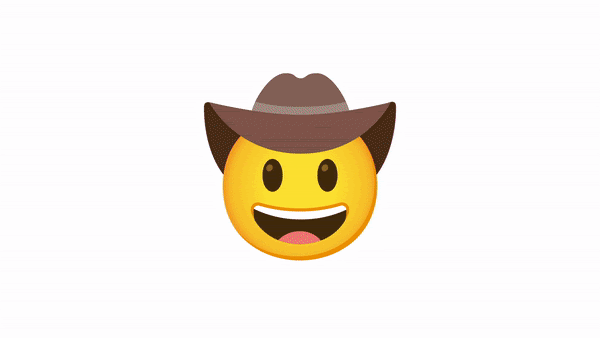Emoji that Can Dance 🪩
The latest Noto Emoji update supports 300 animations including a pink heart that throbs, a G.O.A.T. that is true to it's name, and more expressive smileys
Last year, the Noto Emoji project launched over one-hundred animations of the most frequently used emoji like tears of joy, heart eyes, and pile of poo; however, because I didn’t blog about it on the ole bloggy letter did it really happen?
WELLLLLLLL YES. IT DID HAPPEN. Not only that, but over a hundred more have been made and they are ADORABLE lalksdjfalksjdflkasjdflasdf. LOOK AT THIS GOAT.
Editor’s Note: Full disclosure, when not volunteering my time with the Unicode Consortium you can find me, along with some other nerds, developing Noto Emoji.
Beyond SMS Text Messaging
Nostalgia is a drug so I’ll try to refrain from waxing poetic about the emoji of the 90’s and their radical exuberance, innocent simplicity, and how they DANCED …
That’s right. Many of the original characters on Japanese phones animated. Behold the dancer emoji via phone operator KDDI 👇👇
Go get it, KDDI dancer.
As we move beyond plain text communications to rich immersive ones — like live streaming and video conferencing — emoji continue to demonstrate their relevance as an affordance to backchannel with others🎙️. Just as a head nod or jotting of notes gives speakers some assurance they’ve said something worth remembering, a heart emoji or a rofl acknowledge that whatever you said was appreciated ❤️ These emotional connections are a big part of how we show empathy and build relationships 🥲

With the added value of animation — which can be very effective at emphasizing emotions — we have a compelling recipe for emoji to kick it up a notch and evolve with the internet of the future. Language doesn’t stand still and emoji don’t have to either.
But there’s a catch.

If an emoji can jiggle wiggle does it mean it should jiggle wiggle?
Emoji are intended to represent a broad number of purposes. For example, falling leaves (🍂) can be used literally (falling leaves) but also figuratively (Autumn). Emoji are also used in deeply obscure and personal ways (show me an emoji that isn’t about sex and I’ll show you someone who lacks an imagination). So, how do we ensure that animated equivalents don’t result in unintentionally changing their communicative function?
It turns out dancing emoji don’t have the autonomy that you might expect. (OK OK OK I will admit … clapping turtle is taking some creative liberties but I will protect this tortoise with my life.) Designing emoji isn’t so much an act of artistic expression as it is a drawing séance — gathering historical record, familiarizing yourself with empirical citation and use and pulling it into the future.
While it’d be easy to say that these animations are less likely to fall victim to the fragmentation of their emoji elders because they’re just a bag of bitmapped images and not technically packaged as a font1 the truth is they are inextricably linked. Animated emoji are derivative of Unicode Emoji and inherit both the advantages and disadvantages that come with their popularity.
Two big advantages? They appear everywhere there is a compose field and as a result we’re intimately familiar with them. Consequently, there is a reasonable expectation that emoji behave the same (or meaningfully similar) no matter what app you’re in. It’s deeply troubling when the thing you write changes after you’ve written it. If emoji are intended for the explicit purpose of communicating the last thing we need is animation fragmentation: “tears of joy” (😂) belly laughing in one messaging app and what appears to be profusely sweating in another. lololol WHO WANTS TO BE MISUNDERSTOOD? Oy.
How to Use Animated Emoji
That’s why we made a website dedicated to these animated reactions so everyone can use them. Maybe you've seen them in Google Meet, Messages, or in YouTube. Easy for developers to integrate, citizens of the internet to download and upload to their favorite Discord server or sprinkle into their Slides presentation.
Scan the collection, watch them dance, and download in your preferred file format (We got something for everyone with avif, webp, and gifs). The website includes documentation for the animations, provides guidance on technical setup, and addresses other frequently asked questions around emoji like licensing (Saved you a click: The artwork is available under the CC BY 4.0 license).
With that … I leave you with this peak peacock, peacocking 😍
… oh yeah, and you can collage them together to make this …
Oh, I can’t hit send without sharing the waddling goose, magical unicorn, and eager pupper
OK. I’ll stop now!!!!
Happy emoting,
jd
Quick Unicode primer for those who haven’t read the bloggy letter before: Every letter you are reading on this screen is assigned a code point. The Letter A? It’s code point U+0041. When you send “A” to someone else there is a reasonable expectation that they will also see the letter “A”. (The letter א? Code point U+05D0. The letter ß? Code point U+00df, etc.) This operates the same for emoji: Tear of Joy emoji 😂 maps to code point (U+1F602). Every operating system has system level fonts including emoji which is why emoji sometimes look different.













As always a brilliant and informative read. Thank you 😊
Love these! But the "scan the collection" link isn't working? It seems to redirect to a Google account login page...